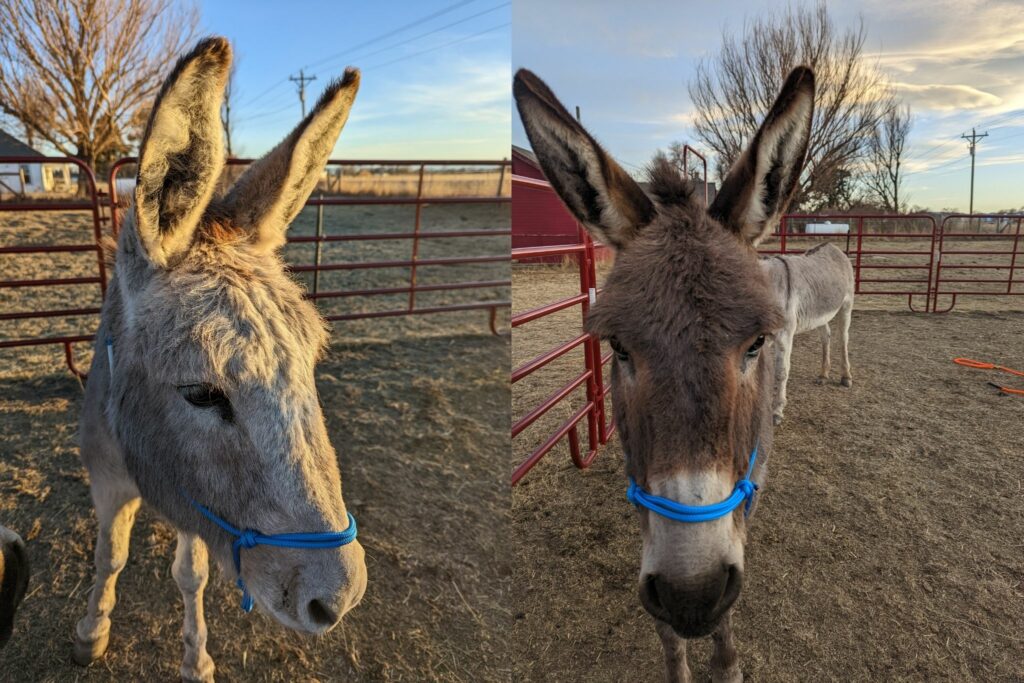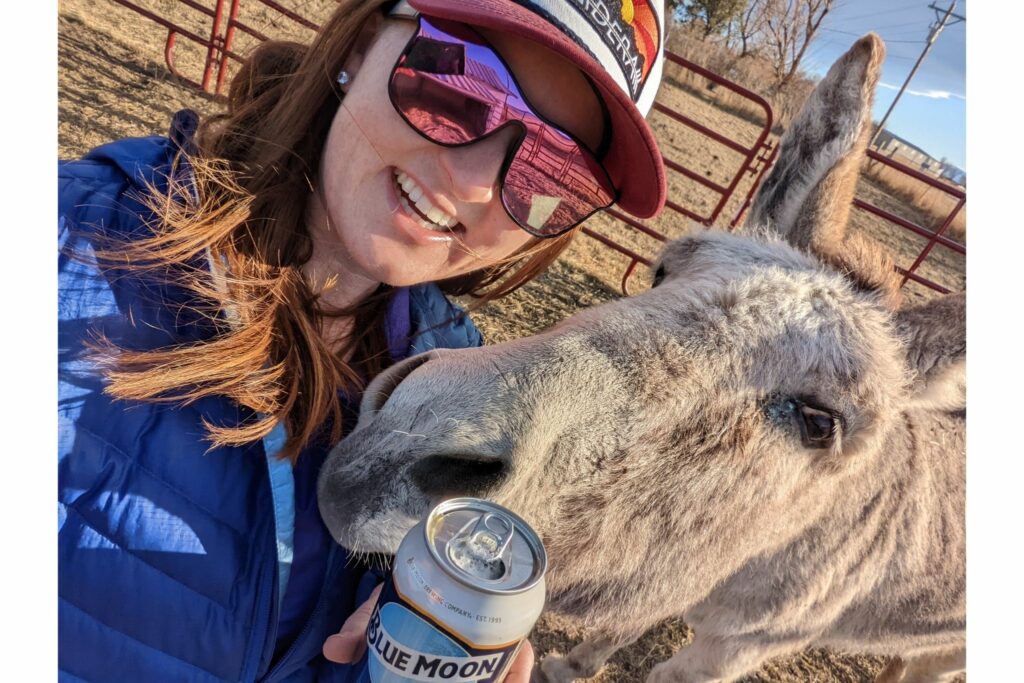Horse News
Member
What Works & What Doesn’t with Wild Burros
Halter training can be difficult with any animal. Halter training a wild burro has proved to be extra challenging!
Training any animal is best done with an abundance of patience, consistency, and carrots. Halter training is no exception! When facing a new challenge, breaking it down into individual steps can be helpful.
This allows you to better visualize progress and celebrate the wins. I’ve broken down halter training into five steps that have proven effective for my BLM burros, Blue and Moon.
The Backstory
We decided to adopt two wild burros from the Bureau of Land Management last year. We selected two male donkeys in October 2021. At that point in time, they were untouched by humans (except for a traumatic vet visit, where they were gelded) and would only come within about six feet of us.
We named them Blue and Moon (yes, after the beer!) and hoped to have them home by Christmas.
By January, they were accepting nose pets for carrots…and that was about it. Be it age, temperament, weather, or a combination of multiple factors, Blue and Moon were progressing slower than average.
Unfun Fact: Did you know donkeys can get grumpy and less cooperative in bad weather, such as snow or very cold temperatures?
We brought them home at the end of February. They had each worn a halter once or twice at this point and were pretty comfortable with head and neck pets in exchange for carrots. Our first project? Getting them halter trained.
You can’t just walk up and halter a half-wild donkey, so I broke the process down into five steps. This made it less intimidating, allowed us to practice different pieces separately, and celebrate small moments of success.

Photo Cred: Susanna Wright
Haltering a Wild Burro in Five Steps
1) Visual Desensitization
Get your donkey familiar with seeing the halter. I would hang it on the fencing, wear it around my neck, hang it on the water bucket, or put it over their feed pans. Make sure they are comfortable approaching you with the halter.
- This may take days, weeks, or even months!
- My Arizona burros think anything rope-like is a snake, so this desensitization process took a long time. We had many sleepovers with the snakes!
2) Nose-First
Make a game out of everything you do! Our donkeys are most comfortable approaching me nose-first, so the first touching step we did was teaching them to put their noses next to and then through the halter to get a carrot. I call this game “Nose for Carrot.”
- One of our donkeys in particular is very food motivated, so this was an effective way to get him to engage with the new item!
- Donkeys are smart—talk to them throughout the process and teach them various commands as you go.
3) Side Views
Next, have the donkey step past you to get the carrot, while holding the halter out to the side. This gets them used to seeing the halter (and you) on their side, where you’ll need to be positioned in order to fasten it.
- Start with no touching, then gradually progress to touching their neck/throatlatch area with the halter
- I’d suggest avoiding any ear-touching at this phase! Blue and Moon are both very sensitive to ear-touches
4) Halters as a Hat
After you can touch the donkey’s neck with the halter without flinching or moving away, progress to gently lay the halter across the top of the neck, behind their ears. I try to get it as close as possible to where it will lie when worn properly. Continue to feed carrots and provide positive reinforcement.
5) All Together Now
Have the donkey step past you for “nose for carrot” as you stand on their left side. Once their nose is through the halter, reach over their head, behind the ears, to grab the crown piece. Secure the halter (depending on the style, this may be with a buckle or a knot).
Reward them for making such great progress!

Photo Cred: Susanna Wright
Additional Tips
I use positive reinforcement only for these steps. Our donkeys love carrots! Vocal praise and pets are also recommended.
- Pick your battles. If your donkey decides to exit midway through, let them. You want them to feel safe with the process, not trapped. Everything I do up until this point is on their terms!
- Don’t start something you can’t see through. If you’re short on time, pick an easy task that will leave everyone ending on a good note. Save more challenging sessions for low stress, longer blocks of time.
- Regression is normal! I was able to get halters on both our donkeys about two weeks after getting them. We made great progress until the one-month mark, and then I couldn’t halter either of them again for 2-4 weeks. They make great progress forward, and then what feels like 19 steps backward. I’m told it’s normal!
- Ask for help if you need it. I am brand-new to donkeys and have a lot of questions. It’s important to create a support system so you don’t get overwhelmed and can progress with confidence. Always start simple, then add complexity.

Photo Cred: Susanna Wright
Frequently Asked Questions
Q: How much does a wild burro cost?
You can adopt a wild horse or burro for as little as $125.
Q: How long does it take to halter a donkey?
This can vary greatly, from a day to several months. Blue and Moon have taken several months and are still not consistent. But, I’m not a professional horse/donkey trainer, and work full-time—so they only get about an hour of training a day.
In a professional program, donkeys can progress much faster.
Q: What does halter breaking a donkey mean?
First off, I prefer to use the term “halter training” instead of breaking. Everything I’ve done up until this point has been through positive reinforcement and has been on Blue and Moon’s terms.
Halter training is a necessary part of training—the donkeys need to be able to be handled for veterinary care, farrier work, and for basic daily handling such as turnout, feeding, and grooming.

Photo Cred: Susanna Wright
Parting Thoughts
Training a wild burro can be exceptionally challenging. Practice patience and consistency—and celebrate the small successes! Carrots also help. Donkeys are highly intelligent animals and working with them can be very rewarding.
Want to learn more? Follow Blue and Moon as they progress on Instagram and TikTok.
P.S. Enjoy this article? Trot on over to:
- Owning Donkeys for Beginners (Pros, Cons, What to Expect)
- Safety First: How Much Can a Donkey Carry?
- 13 Best Treats and Toys for Busy-Minded Donkeys
- Donkey vs. horse nutrition: What’s the difference?
- 5 Simple Tips to Help An Abused Horse
- Dangerous Horse: The Result of Being Abused
- Why horses are dangerous (but worth the risk!)
- 3 Fear-Free Secrets to Gain Your Horse’s Trust & Respect
- Bonding 101: How to Make the Most of Your Horse Time
The post 5 Simple Steps to Halter Training Your Wild Donkey appeared first on Horse Rookie.
Continue reading...
